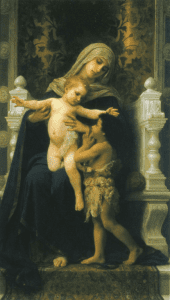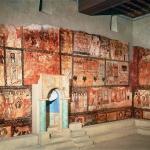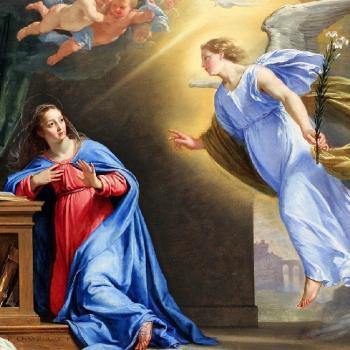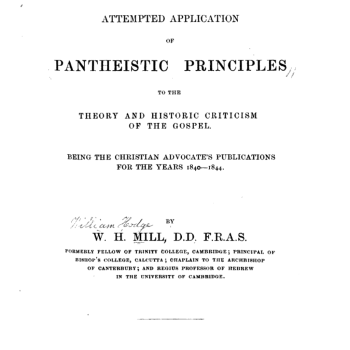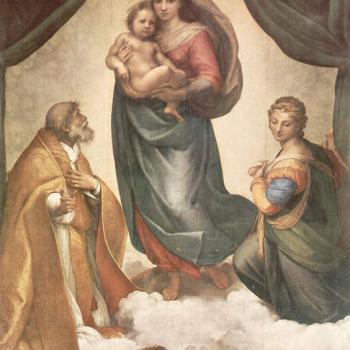This is a guest post from Catholic theologian, Dr. Robert Fastiggi. He holds the Bishop Kevin M. Britt Chair of Christology, Professor of Dogmatic Theology at Sacred Heart Major Seminary in Detroit, Michigan. Dr. Fastiggi received an M.A. in Theology from Fordham University in 1976; and a Ph.D. in Historical Theology from Fordham in 1987. At Sacred Heart, he has taught courses on Ecclesiology, Christian Anthropology, Christology, Mariology, Moral Theology, and the Sacramental Life of the Church. He is a member of the Society for Catholic Liturgy and has been president of the Mariological Society of America.
Dr. Fastiggi has served as the executive editor of the 2009-2013 supplements to the New Catholic Encyclopedia and as co-editor and translator of the English translation of the 43rd edition of the Denzinger-Hünermann Enchiridion Symbolorum (Ignatius Press: 2012): the standard compendium of Catholic doctrines and dogmas. He has also translated and updated the German revised edition of Ludwig Ott’s well-known reference work, Fundamentals of Catholic Dogma (Baronius Press, 2018). He has written many articles for Catholic websites / magazines such as Where Peter Is, The Catholic World Report, and my own blog.
*****
“Please Hit ‘Subscribe’”! If you have received benefit from this or any of my other 4,500+ articles, please follow this blog by signing up (w your email address) on the sidebar to the right, above where there is an icon bar, “Sign Me Up!”: to receive notice when I post a new blog article. This is the equivalent of subscribing to a YouTube channel. Please also consider following me on Twitter / X and purchasing one or more of my 55 books. All of this helps me get more exposure, and a bit more income for my full-time apologetics work. Thanks so much and happy reading!
*****
[Full title: “Mary Mother of the Church highlights Mary’s Spiritual Motherhood”]
Introduction
In a Decree dated Feb. 11, 2018 (but released March 3), Cardinal Robert Sarah, Prefect of the Congregation for Divine Worship and the Discipline of the Sacraments, announced that “Pope Francis has decreed that the Memorial of the Blessed Virgin Mary, Mother of the Church, should be inscribed in the Roman calendar on the Monday after Pentecost and be celebrated every year.” This means that in the Latin Rite, the celebration of the Blessed Virgin Mary, Mother of the Church—as an obligatory Memorial—will have precedence over any other memorial of a Saint or Blessed on the Monday following Pentecost.
The foundation for the new obligatory memorial
In the Feb. 11, 2018 Decree, Cardinal Sarah points to St. Paul VI’s Nov. 21, 1964 Address at the conclusion of the Third Session of the Second Vatican Council as the clear foundation for the memorial of Mary, Mother of the Church. During this address, Paul VI declared the Blessed Virgin Mary to be “Mother of the Church that is to say of all Christian people, the faithful as well as the pastors, who call her the most loving Mother.” He also established that “the Mother of God should be further honored and invoked by the entire Christian people by this most tender of titles”. Because of Paul VI’s 1964 proclamation, a votive Mass in honor of “Blessed Mary Mother of the Church” (Beata Maria Ecclesiæ Matre) was proposed during the 1975 “Holy Year of Reconciliation” and later inserted into the Roman Missal. In 1980, the title of Mary as “Mother of the Church” was added to the Litany of Loreto with papal approval. In the 1986 “Collection of Masses of the Blessed Virgin Mary” three formularies for the celebration of “the Blessed Virgin Mary, Image and Mother of the Church” were included. Some countries, dioceses, and religious families have already been celebrating the memorial of Mary, Mother of the Church, with approval from the Holy See.
Scriptural and theological foundations
The recognition of Mary as “Mother of the Church” has deep biblical roots. As the New Eve and “mother of the living’ (Gen 3:20), Mary takes on a maternal role toward all humanity, especially the faithful. As Mother of the Incarnate Word, Mary is the Mother of all the faithful who are joined to the Mystical Body of Christ, which is the Church (cf. Rom 12:5; 1 Cor 10:16–17; 12:12–31; Eph 1:22–23, 5:23 –30; and Col 1:18–24). In his Nov. 21, 1964 address, Blessed Paul VI notes that, as soon as Christ took on a human nature in Mary’s virginal womb, He united to himself, as its head, his Mystical Body, which is the Church.” Therefore, “Mary, as the Mother of Christ, must be regarded as the Mother of all the faithful and pastors, which means the Church.”
In his Feb. 11, 2018 Decree, Cardinal Sarah points to John 19:25–27 for understanding Mary as Mother of the Church:
… the Mother standing beneath the cross (cf. Jn 19:25), accepted her Son’s testament of love and welcomed all people in the person of the beloved disciple as sons and daughters to be reborn unto life eternal. She thus became the tender Mother of the Church which Christ begot on the cross handing on the Spirit.
St. John Paul II likewise sees John 19:25–27 as instrumental for understanding Mary as Mother of the Church. In his General Audience of Sept. 17, 1997, he observes: “On Calvary, Mary united herself to the sacrifice of her Son and made her own maternal contribution to the work of salvation, which took the form of labor pains, the birth of the new humanity.” He goes on to say that “in addressing the words ‘Woman, behold your son’ to Mary, the Crucified One proclaims her motherhood not only in relation to the Apostle John but also to every disciple.”
The Assumption of the Blessed Virgin Mary into heaven also manifests Mary as the spiritual Mother of the Church. After being assumed into heaven, Mary, “by her constant intercession” continues to bring us the gifts of eternal salvation, and “by her maternal charity,” she cares for us “who still journey on earth surrounded by dangers and difficulties” until we are led into the happiness of our “true home” (Lumen Gentium, 62).
Mary, therefore, is Mother of the Church because she is the Mother of Christ, who is the head of the Mystical Body, the Church. Given to us as our Mother by the dying Lord on the Cross, Mary continues to intercede for us with maternal love from heaven. In a special way Mary’s spiritual motherhood is linked to Pentecost because, as the mystical Spouse of the Holy Spirit, Mary joins with the Church in prayer, and she is “the perfect image of what it means to be a disciple of Christ,” the “mirror of all the virtues,” and “the definitive model for the perfect imitation of Christ” (Paul VI, Nov. 21, 1964). As the Mother of the faithful, Mary is the exalted “type” or exemplar of the Church because “in the most holy Virgin the Church has already reached that perfection whereby she is without spot or wrinkle” (Lumen Gentium, 65).
Historical witness to the title, “Mother of the Church”
The title “Mother of the Church” has roots in Fathers of the Church. St. Augustine (354–430) sees Mary as “the mother of the members of Christ . . . having cooperated by charity so the faithful might be born in the Church, who are members of that Head” (De sancta Virginitate, 6; cited in LG, 53). St. Leo the Great (c. 400–461) states that “Christ’s generation is the origin of the Christian people; and Christ’s birth as head is also the birth of his Mystical Body” (Sermon 6 on the Nativity of the Lord). In the Middle Ages, St. Anselm (1033–1109) speaks of Mary as “the Mother of justification and the justified; the Mother of reconciliation and the reconciled; the Mother of salvation and of the saved (Or 52, 8). Pope Benedict XIV, in his Sept. 27, 1748 bull, Gloriosae Dominae, states that Mary on Calvary is “in the proper sense Mother of the Church, a gift the Church received from lips of her dying Bridegroom” (Bullararium 2, 428). Pope Leo XIII, in his Sept. 5, 1895 encyclical, Adiutricem, extols Mary as “the Mother of the Church, the Teacher and Queen of the Apostles” (no. 6).
After Leo XIII, popes refer to Mary as Mother of the Church explicitly or in equivalent terms. In his address of Dec. 4, 1963, at the close of the Second Session of Vatican II, Paul VI expressed his hope that Mary would be honored with the title, “Mother of the Church” in the Constitution of the Church (cf. no. 21 in the address). An earlier title of what would be chapter VIII of Lumen Gentium was: “On the Blessed Virgin Mary, Mother of the Church.” This title, though, was changed to its present one, “On the Blessed Virgin Mary, Mother of God, in the Mystery of Christ and the Church.” About 200 bishops asked that the earlier title be restored, but the Theological Commission responded by noting that the revised title better corresponded to the contents of the chapter. Moreover, Mary, as Mother of the Church, is expressed in equivalent terms in LG, 53, which states that “The Catholic Church, taught by the Holy Spirit, honors [Mary] with filial affection and piety as a most beloved mother.” Some Council fathers also had ecumenical concerns that referring to Mary as “Mother of the Church” might imply that the Church owes its existence to her and not to Christ. A good number of bishops—most notably Cardinal Wyszynski and the bishops of Poland—appealed to Pope Paul VI to proclaim Mary as Mother of the Church on his own authority. The Holy Father responded to this request favorably, and he solemnly proclaimed Mary as “Mother of the Church” in his address of Nov. 21, 1964.
The hoped-for fruits of the Memorial of Mary, Mother of the Church
In his Commentary on the Feb. 11, 2018 Decree, Cardinal Sarah states that Pope Francis believes this new obligatory memorial will highlight “the mystery of Mary’s spiritual motherhood, which from the awaiting of the Spirit at Pentecost has never ceased to take motherly care of the pilgrim Church on earth.” The Holy Father also hopes that the memorial will help us root our spiritual lives “firmly on three great realities: the Cross, the Eucharist, and the Mother of God.” Celebrating Mary as Mother of the Church on the Monday after Pentecost will help us all realize how important Mary, the mystical spouse of the Holy Spirit, is to our lives as Christian. She is truly “our Mother in the order of grace” (Lumen Gentium, 61), She is united to Christ, the Head of the Church “by a close and indissoluble bond” (Lumen Gentium, 53), and she is united to us as our spiritual Mother, the Mother of the Church.
*
***
*
Practical Matters: Perhaps some of my 4,500+ free online articles (the most comprehensive “one-stop” Catholic apologetics site) or fifty-five books have helped you (by God’s grace) to decide to become Catholic or to return to the Church, or better understand some doctrines and why we believe them.
Or you may believe my work is worthy to support for the purpose of apologetics and evangelism in general. If so, please seriously consider a much-needed financial contribution. I’m always in need of more funds: especially monthly support. “The laborer is worthy of his wages” (1 Tim 5:18, NKJV). 1 December 2021 was my 20th anniversary as a full-time Catholic apologist, and February 2022 marked the 25th anniversary of my blog.
PayPal donations are the easiest: just send to my email address: [email protected]. Here’s also a second page to get to PayPal. You’ll see the term “Catholic Used Book Service”, which is my old side-business. To learn about the different methods of contributing (including Zelle), see my page: About Catholic Apologist Dave Armstrong / Donation Information. Thanks a million from the bottom of my heart!
*
***
Photo credit: The Virgin, the Child Jesus, and St John the Baptist (1881), by William-Adolphe Bouguereau (1825-1905) [public domain / Wikimedia Commons]
Summary: Catholic theologian Robert Fastiggi summarizes the background of this description of the Blessed Virgin, which was highlighted (not introduced!) at Vatican II.


